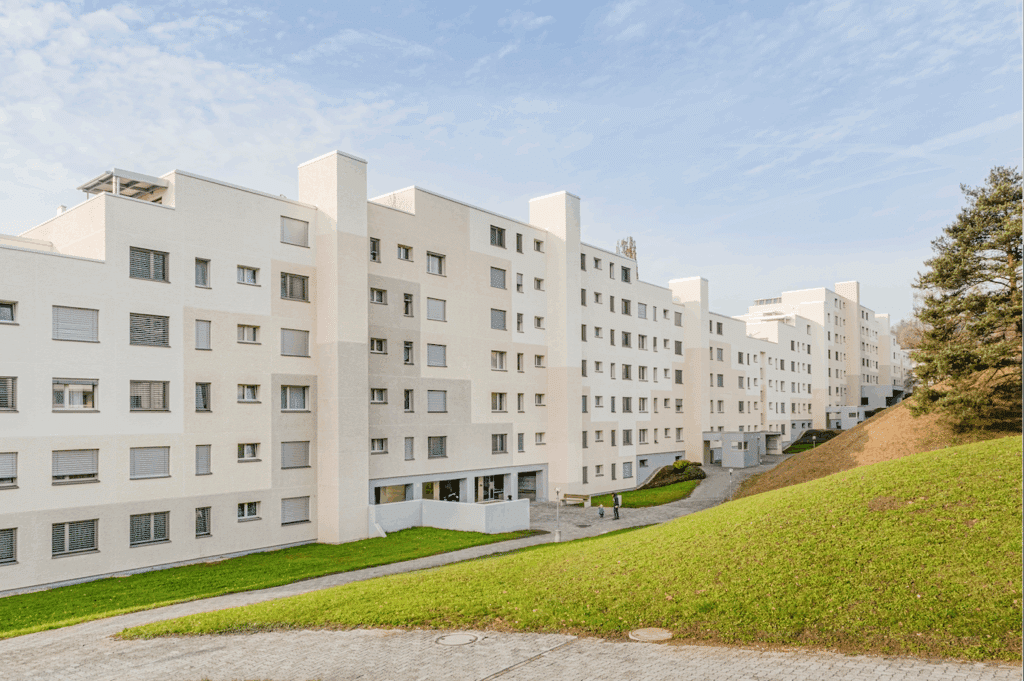We are standing here between the prefabricated buildings, the facades have all been renovated and the green spaces are park-like and well-maintained. What is your first impression?
The settlement has really come into its own. When I first came here, the area with the 13 blocks, or row buildings in technical jargon, was considered a problem area. High youth crime, no neighborhood identity, lack of public spaces to meet – it was a bleak first impression. Today I still see key measures that I recommended back then actively in place – a good feeling.
What do you particularly notice?
The project originally focused on young people – which is why the municipality approached me at the time. But I quickly realized that it wasn’t just about young people with problems, but about an entire district without prospects for the settlements. We then decided to focus on a holistic approach. And I am particularly pleased that this now seems to be implemented.
How did you proceed?
For the analysis, I combined several methods, including conducting interviews on site, which was quite frightening at the time. Because not only were drugs being traded, but also weapons. In order to get a complete picture of this social space, I also came here several times at night. In addition to such observational inspections, I also interviewed families, male and female young people, and the trusted people in schools. I also evaluated the statistical data of the municipality, studied the site plans and noted the critical locations on my tours.
«In order to get a complete picture of this social space, I also came here several times at night. I also evaluated the statistical data of the municipality, studied the site plans and noted the critical locations on my tours.»
Christine Hotz
What were your findings?
You have to imagine: almost 2,000 people from a good 50 nations lived here. There was a lack of settlement or neighborhood identity among the residents, especially among those who had only lived here for a few years. The 20 administrations of the blocks lacked an overarching strategy for the entire settlement. But also the understanding that it needs this – only four administrations filled out the questionnaire at the time. We must remember that we are talking about the second largest prefabricated building settlement in Switzerland, which the construction company Göhner had built from the end of the 1970s. From the vision of offering affordable housing for the middle class, I encountered, to put it bluntly, the nightmare of the ghettoized agglomeration. But I was positive: in the individual interviews I sensed the willingness and the will to develop the neighborhood.

So is everything good now, when you look around?
It would be grossly negligent to make a final judgment based solely on our tour – my analysis has just shown that it requires an in-depth examination. I recommended a variety of measures at the time. Some were easy to implement without much effort, others were longer-term and involved costs. I also see such major measures being implemented in the meeting center or the small coffee restaurant. But the small shopping street does not seem to have worked. But I can imagine that this is less due to the neighborhood itself than to the overall decline of small shops; the large chain stores are not far from here. But there is now a meeting center that takes care of the neighborhood – these are already much better framework conditions!
And what is your conclusion today?
Following the analysis, the project was further developed with the support of the HSLU and various funds were allocated to develop the settlement. If you look at the costs for the project, you have to say that the costs for the settlement development were very low. In return, there are now central places where you can meet, the parking areas look well-maintained – there is no littering. The municipality has become active, which is a prerequisite for developing a neighborhood together with the administrations. All of this naturally involves effort. But when I stand here in the sun and look around: it was worth it.
About Christine Hotz
Christine Hotz works as a project manager at enovation. Here, in an on-site interview, she presents her award-winning project, whose methodology as well as the approach of low-threshold neighborhood development are still groundbreaking today.
